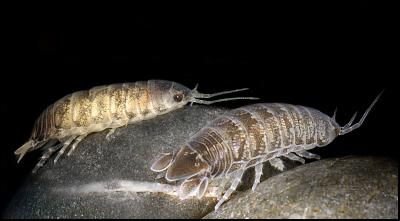Nippy creatures that share your swim

Cirolana found at Island Bay. Photo credit Niel Bruce
Nippy creatures that share your swim
There you are at the beach this summer. The water is cool and inviting. You go in for a dip. Then something small nips you. Most people would immediately blame a crab but it could be sea louse – a marine isopod! Isopods are a type of crustacean, like a garden slater. Some of the marine ones nibble on seaweed but sea lice also like eating animals, especially dead animals.
In New Zealand the incidence of people getting
‘nipped’ is actually rather low, even though sea lice
are found in intertidal, rocky and sandy shores all around
the country.
They are more of a minor nuisance than a
real danger to humans.
Worldwide there are 450 species of sea lice and beach lice, also known as cirolanid isopods, but ours are not well documented.
In New Zealand, 17 species in six genera have been recorded, but some of the species that are common around our shores have yet to be described. NIWA biodiversity scientist Dr Dennis Gordon remarks that about 370 species of marine isopods have been named and described out of an estimated 1000 species.
Dr Niel Bruce, Senior Curator at the Queensland Museum says, “It is thought that the intertidal cirolanids on beaches are a species of Pseudaega, a genus endemic to New Zealand and found on suitable sandy beaches around New Zealand. The genus Eurylana also occurs on sand beaches, but it is thought to prefer more subtidal, deeper habitats.”
On rocky shores, such as Island Bay in Wellington, the species Cirolana kokuru is common, at times abundant. This species reaches 1cm in size and could be what nips you when you are kneeling on the rocky shore at low tide, especially on a late afternoon rising tide.
Cirolana kokuru was once involved in a police investigation of a tragic multiple murder–suicide. When the bodies were found, these isopods had chewed their way into the corpses.
A single trap set overnight can yield as many as 30,000 individuals, which suggests that cirolanids must be of some ecological significance and finding them on the corpses hints at what that might be.
“These beautiful creatures are marine
garbage cleaners,” says Dr Bruce. “These scavengers are
important in maintaining the general health of ecosystems,
particularly through cleaning up dead animal
matter.”
ends


 Business Canterbury: Urges Council To Cut Costs, Not Ambition For City
Business Canterbury: Urges Council To Cut Costs, Not Ambition For City Wellington Airport: On Track For Net Zero Emissions By 2028
Wellington Airport: On Track For Net Zero Emissions By 2028 Landcare Research: ANZAC Gall Fly Release Promises Natural Solution To Weed Threat
Landcare Research: ANZAC Gall Fly Release Promises Natural Solution To Weed Threat NZ Anti-Vivisection Society: Auckland Rat Lovers Unite!
NZ Anti-Vivisection Society: Auckland Rat Lovers Unite! University of Canterbury: $1.35 Million Grant To Study Lion-like Jumping Spiders
University of Canterbury: $1.35 Million Grant To Study Lion-like Jumping Spiders Federated Farmers: Government Ends War On Farming
Federated Farmers: Government Ends War On Farming



